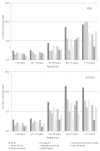Sociodemographic characteristics and chronic medical conditions as risk factors for herpes zoster: a population-based study from primary care in Madrid (Spain)
- PMID: 24805130
- PMCID: PMC5396250
- DOI: 10.4161/hv.28620
Sociodemographic characteristics and chronic medical conditions as risk factors for herpes zoster: a population-based study from primary care in Madrid (Spain)
Abstract
The objectives of this study were to estimate incidence density rates (IDR) of herpes zoster (HZ) and to analyze the association with sociodemographic characteristics and selected chronic medical conditions. The study cohort consisted of the adult population included in the Public Health System of the Autonomous Community of Madrid, Spain on 1/10/2009 (5 244 402 persons). Data source were electronic medical records from primary care between 1/10/2009-31/12/2012. Individual socioeconomic status (SES) was inferred by geocoding. Poisson regression analyses were stratified by sex, to identify factors associated with HZ. We identified 81 541 incident cases of HZ (61.7% in women and 46.5% in the group aged 60 and over). IDR was 4.11 per 1000 person-years in men and 5.95 in women. IDR were higher with age, in autochthonous population, those with lower SES and in patients with immunodeficiencies. After adjustment, higher incidence rate ratios were found with age, autochthonous origin, lower SES, and in patients with HIV-infection/AIDS (3.20, CI95% 2.90-3.53 in men and 2.98, CI95% 2.58-3.45 in women), and other immunodeficiencies (1.57, CI95% 1.41-1.75 and 1.65, CI95% 1.50-1.80). COPD, asthma, DM, ischemic heart disease, other cardiovascular diseases, and cancer were also associated with an increased incidence of HZ. We conclude that older, autochthonous patients with lower SES and with certain underlying medical conditions had a higher probability of suffering HZ. Electronic databases are useful for estimating the incidence of HZ, and for finding associations with sociodemographic and clinical characteristics. Identifying unrecognized risk factors for HZ, such as asthma or cardiovascular diseases, is crucial to interpret the epidemiology of HZ, to target vaccination programs and to monitor their effect.
Keywords: chronic conditions; herpes zoster; incidence; primary health care; risk factor; vaccine; varicella.
Figures
References
-
- Harpaz R, Ortega-Sanchez IR, Seward JF, Advisory Committee on Immunization Practices (ACIP) Centers for Disease Control and Prevention (CDC) Prevention of herpes zoster: recommendations of the Advisory Committee on Immunization Practices (ACIP) MMWR Recomm Rep. 2008;57(RR-5):1–30, quiz CE2-4. - PubMed
-
- Yih WK, Brooks DR, Lett SM, Jumaan AO, Zhang Z, Clements KM, Seward JF. The incidence of varicella and herpes zoster in Massachusetts as measured by the Behavioral Risk Factor Surveillance System (BRFSS) during a period of increasing varicella vaccine coverage, 1998-2003. BMC Public Health. 2005;5:68. doi: 10.1186/1471-2458-5-68. - DOI - PMC - PubMed
MeSH terms
LinkOut - more resources
Full Text Sources
Other Literature Sources
Medical

